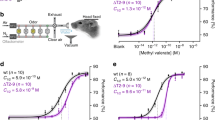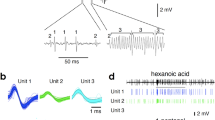Abstract
Tiger salamanders generalize behaviorally between carbonyl-containing odorants (e.g., aldehydes or cycloalkanones). However, responding does not generalize from such odorants to stimulus compounds with comparable molecular shapes and dimensions but different functional groups. Discrimination between aldehydes and a ketone is temporarily impaired by two-step covalent modification of the olfactory epithelium. Two-step modification of the olfactory epithelia also impairs, but does not obliterate, olfactory detection, and generalization persists even during the period of impairment. These results are interpreted as implying the existence of carbonyl-binding, “generalist” olfactory receptors in addition to other classes of “generalist” receptors that are not affected by two-step modification. Generalization is inferred to require overlap in the response profile of more than one class of receptor.
Similar content being viewed by others
References
Arzt, A.H., Silver, W.L., Mason, J.R., andClark, L. 1986. Comparison of olfactory receptor responses in land and water phase tiger salamanders.J. Comp. Physiol. A. 158:479–487.
Cagan, R.H. 1981. Recognition of taste stimuli at the initial binding interaction,in R.H. Cagan and M.R. Kare, (eds.).Biochemistry of Taste and Olfaction. Academic Press, New York, pp. 175–209.
Chapman, O.L., Mattes, K.C., Sheridan, R.S., andKlun, J.A. 1978. Stereochemical evidence of dual chemoreceptors for an achiral sex pheromone in Lepidoptera.J. Am. Chem. Soc. 100:4878–4884.
Daub, G.W., Zuckerman, R.N., andJohnson, W.S. 1985. A synthesis of 2-fluoroalkenes.J. Org. Chem. 50:1599–1602.
D'Ischia, M., Prota, G., andSodano, C. 1982. Reaction of polygodial with primary amine: An alternative explanation to the antifeedant activity.Tetrahedron Lett. 23:3295–3298.
Eichenbaum, H., Morton, T.H., Potter, H., andCorkin, C. 1983. Selective olfactory deficients in case H.M.Brain 106:459–472.
KÖster, E.P. 1971. Adaptation and Cross-Adaptation in Olfaction. PhD thesis, Utrecht.
Kuntz, A. 1923. The learning of a simple maze by the larvae ofAmbystoma tigrinum.Iowa Univ. Stud. Nat. Hist. 10:27–35.
Lambert, J.B., Koeng, F.R., andHamersma, J.W. 1971. The Tricyclo[5.1.0.03,5]-octan-2-ols.J. Org. Chem. 36:2941–2942.
Lespieau, R., andBourguel, M. 1941. 3-Cyclohexyl-2-bromopropene.Org. Synth. Coll. 1:186–187.
Mason, J.R., andMorton, T.H. 1982. Selective and reversible anosmia in tiger salamanders (Ambystoma tigrinum) caused by chemical treatment of the olfactory epithelium.Physiol. Behav. 29:709–714.
Mason, J.R., andMorton, T.H. 1984. Fast and loose covalent binding of ketones as a molecular mechanism in vertebrate olfactory receptors. Chemical production of selective anosmia.Tetrahedron 40:483–492.
Mason, J.R., andStevens, D.A. 1981a. Discrimination and generalization among reagent grade odorants by tiger salamanders (Ambystoma tigrinum).Physiol. Behav. 27:647–653.
Mason, J.R., andStevens, D. A. 1981b. Behavioral determinations of thresholds forn-butyl acetate andn-butyl alcohol in the tiger salamander (Ambystoma tigrinum).Chem. Senses 6:189–195.
Mason, J.R., Stevens, D.A., andRabin, M.D. 1980. Instrumentally conditioned avoidance by tiger salamanders (Ambystoma tigrinum) to chemically pure odorants.Chem. Senses 5:99–105.
Mason, J.R., Meredith, M., andStevens, D. A. 1981. Odorant discrimination by tiger salamanders after combined olfactory and vomeronasal nerve cuts.Physiol Behav. 27:125–132.
Mason, J.R., Clark, L., andMorton, T.H. 1984. Selective deficits in the sense of smell caused by chemical modification of the olfactory epithelium.Science 226:1092–1094.
Mason, J.R., Leong, F.-C., Plaxco, K.W., andMorton, T.H. 1985. Two-step covalent modification of proteins. Selective labelling of Schiff base-forming sites and selective blockade of the sense of smell.J. Am. Chem. Soc. 107:6075–6084.
Schneider, D. 1969. Insect olfaction: Deciphering system for chemical messages.Science 163:1031–1037.
Winer, B.J. 1962. Statistical Principles in Experimental Design. McGraw-Hill, New York.
Author information
Authors and Affiliations
Rights and permissions
About this article
Cite this article
Mason, J.R., Johri, K.K. & Morton, T.H. Generalization in olfactory detection of chemical cues containing carbonyl functions by tiger salamanders (Ambystoma tigrinum). J Chem Ecol 13, 1–18 (1987). https://doi.org/10.1007/BF01020347
Received:
Accepted:
Issue Date:
DOI: https://doi.org/10.1007/BF01020347




